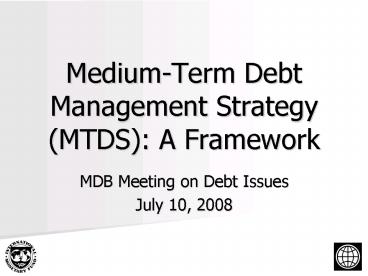Medium-Term Debt Management Strategy (MTDS): A Framework - PowerPoint PPT Presentation
1 / 18
Title:
Medium-Term Debt Management Strategy (MTDS): A Framework
Description:
Improves evaluation of cost-risk tradeoff Improves risk measurement and management Facilitates policy ... accompanied by a User s Guide A ... MTDS formulation ... – PowerPoint PPT presentation
Number of Views:184
Avg rating:3.0/5.0
Title: Medium-Term Debt Management Strategy (MTDS): A Framework
1
Medium-Term Debt Management Strategy (MTDS) A
Framework
- MDB Meeting on Debt Issues
- July 10, 2008
2
Motivation
- Post MDRI perspective
- New borrowing opportunities ? new risks
- A clear framework to fully assess the related
costs and risks of new financing is absent in
many cases - Shareholders of the World Bank and IMF have
instructed both instituions to scale-up work
program to help improve debt management in LICs - MTDS aims to provide coherent framework to fully
assess relevant costs and risks of new financing
3
What is an MTDS?
- A framework to fully assess relevant costs and
risks associated with a governments desired
composition of debt - It is a document that describes the plan that the
government intends to implement to achieve this
composition - Medium-term planning horizon of the government
(usually 3-5 years)
4
What is an MTDS?
- The principal benefit of a MTDS It can help a
country avoid expensive mistakes. - Improves evaluation of cost-risk tradeoff
- Improves risk measurement and management
- Facilitates policy coordination
- Facilitates domestic debt market development
5
What is an MTDS?
- MTDS Toolkit
- Guidance Note a step-by-step how-to guide on
the process of developing and implementing an
MTDS. - Scenario Analysis Model (spreadsheet-based
analytical tool) to help compare alternative
strategies under different scenarios for future
market rates, accompanied by a Users Guide - A template for strategy documentation
6
Debt Management, Macroeconomic Framework and
Market Constraints
7
Designing an MTDS
- Objectives and scope of the MTDS
- Cost and risk of existing debt
- Potential sources of finance
- Medium-term macro-policy and market environment
- Broad structural factors and risks
- Analysis of alternative debt management
strategies - Review with fiscal, monetary and market
authorities - Propose and approve MTDS
8
Objectives Scope
- Objective
- Identify main objectives for public debt
management and the scope of the MTDS - Outputs
- Description of the overall objectives for public
debt management - Definition of the types of debt to be covered by
the MTDS
9
Cost Risk of Existing Debt
- Objectives
- Identify outstanding debt and its composition
- Calculate basic cost and risk indicators
- Outputs
- Detailed information on outstanding debt
- Debt servicing profile of outstanding debt
- Description of main portfolio risks
10
Potential Instruments Characteristics
- Objective
- Identify potential sources of finance, their
financial characteristics including cost and risk
parameters - Output
- List of existing and potential instruments,
domestic and external, and description of their
financial characteristics - Evaluation of the potential of annual borrowing
in each instrument - Discussion/ranking of the instruments based on
cost/risk characteristics
11
Macro and Market Environment
- Objectives
- Identify the baseline projections for key fiscal
and monetary policy variables, as well as market
rates, the mains risks to this, and the relevant
constraints and implications for MTDS formulation - Output
- Baseline projections for key fiscal, monetary
policy and market variables - A clear and comprehensive set of country specific
risk scenarios to be tested
12
Review Key Longer-term Structural Factors
- Objective
- Review structural factors that will potentially
influence the desired direction of the MTDS over
the longer-term - Output
- Articulation of long-run structural factors that
the MTDS should take into account, e.g., - Commodity price vulnerability
- Macro vulnerabilities created by the debt
composition
13
Analysis of Strategies
- Objectives
- Identify and analyze possible debt management
strategies, assess their performance, and chose a
small number of preferred debt management
strategies - Outputs
- Comparison of feasible debt compositions,
identifying preferences relative to objectives - Comparison of cost and cost-range implications of
debt management strategies - Identify the preferred, and a few alternative
strategies
14
Review with Other Agencies
- Objectives
- Ensure that relevant feedback from the strategies
identified is provided by the fiscal and monetary
policy authorities - Review the potential debt market implications of
the strategies. - Output
- A clear assessment that the candidate strategies
are consistent with fiscal and monetary policies,
maintaining debt sustainability, and in line with
plans for market development
15
Propose Approve the MTDS
- Objective
- Present the preferred and alternative strategies
to the highest responsible authority - Propose the preferred MTDS for approval
- Output
- A document describing the preferred strategy, as
well as a few alternatives - A clear description of the key associated costs
and risks, and relationship with the broad
objectives
16
Disseminating the MTDS
- Once determined, the agreed MTDS should be
disseminated - Inform key stakeholders (e.g. Parliament, primary
dealers, creditors, investors, ratings agencies) - Secures (political) commitment to the strategy
- Reduces uncertainty, increases confidence
- Facilitates active decision-making by the DM
- Enhances transparency and accountability
- Improves the quality of the debate
- Strengthens analysis and (consequently) improves
outcomes - Establishes a reference point to evaluate debt
management performance
17
Implementing the MTDS
- Separate process from strategy formulation
- Operational focus
- Need to identify consistent borrowing plan
- More focused on precise characteristics and
details of instruments - Implementation will highlight key bottlenecks
that constrain the set of feasible strategies,
e.g. - Shallow local debt markets
- Weaknesses in primary market operations
- Potential conflict with operating framework for
monetary policy - Limits on availability of (concessional) external
finance - Link to market development strategy
18
Next Steps
- Field test MTDS toolkit Bangladesh, Ghana,
Cameroon, Nicaragua 2 - Conclude elements of toolkit
- Present progress/experience to Boards in early
2009






























